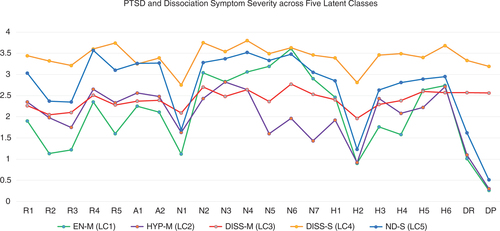Figures & data
Table 1 Principal axis factor analysis with direct oblimin rotation of the 20-item PCL-5 plus depersonalization and derealization items
Table 2 Six factor correlation matrix identified in principal axis factor analysis of the 20-item PCL-5 plus depersonalization and derealization items
Table 3 Fit indices for different latent class solutions (PCL-5 ≥38)
Fig. 1 PTSD and dissociation symptom severity across five latent classes. EN-M=Emotional Numbing—Moderate. HYP-M=Hyperarousal—Moderate. DISS-M=Dissociation—Moderate. DISS-S=Dissociation—Severe. ND-S=Non-Dissociative—Severe. LC=Latent Class. Statistically significant between class differences are reported in .

Table 4 Differences between latent classes in PTSD and depersonalization and derealization symptom frequency
Table 5 Differences between latent classes on latent factors identified by principal axis factor analysis
Table 6 Differences between latent classes in other measures of dissociative experience
Table 7 Differences between latent classes in measures of presumed non-dissociative distress
Table 8 Differences between latent classes in measures of childhood trauma history
